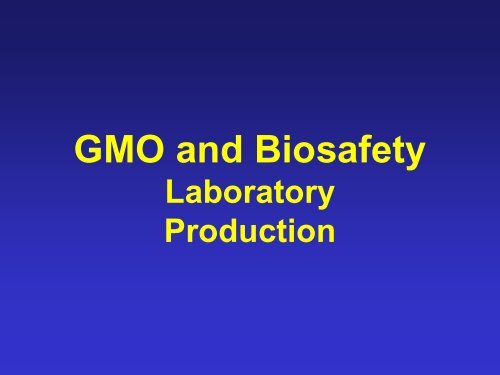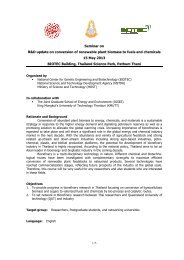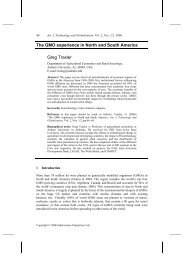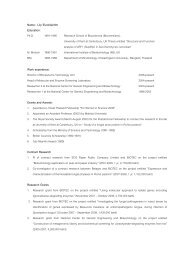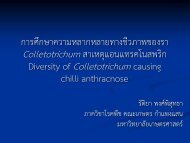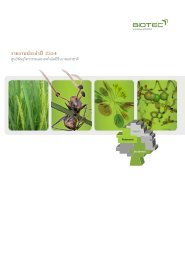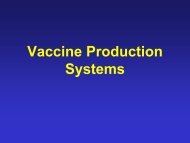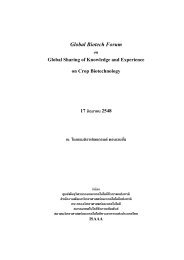Large scale containment
Large scale containment
Large scale containment
You also want an ePaper? Increase the reach of your titles
YUMPU automatically turns print PDFs into web optimized ePapers that Google loves.
GMO and Biosafety<br />
Laboratory<br />
Production
The Bible
NIH Guidelines<br />
“… any rDNA experiment ... must be submitted to NIH<br />
or another Federal Agency that has jurisdiction for<br />
review and approval.”<br />
rDNA Project<br />
Application<br />
Risk assessment<br />
Go / No go<br />
Exemption:<br />
Specific host/vector<br />
systems<br />
Exception?
Pathogen Classes (NIH)<br />
Risk<br />
Group<br />
RG I<br />
RG II<br />
RG III<br />
RG IV<br />
Definition<br />
Agents not associated with disease in<br />
healthy adult<br />
Agents associated with human disease,<br />
rarely serious; preventive or therapeutic<br />
intervention is available<br />
Agents associated with serious or lethal<br />
disease; preventive or therapeutic<br />
intervention may be available; high<br />
individual risk, low community risk<br />
Agents that are likely to cause serious or<br />
lethal disease; preventive or therapeutic<br />
intervention usually not available; high<br />
individual risk, high community risk<br />
Examples<br />
E. Coli K12,<br />
Asporogenic B.<br />
subtilis,<br />
AAV type 1-4<br />
B. Pertussis<br />
H. Influenzae<br />
Dengue, YF 17D ,<br />
Rabies, Hep AE<br />
Y. Pestis<br />
Brucella, JE, YF WT<br />
HIV, HTLV<br />
No bacteria<br />
Ebola, Marburg,<br />
Lassa, H. simiae
Laboratory Handling of Agents<br />
• General rule<br />
• RG I agents BL1 <strong>containment</strong> (≈ no <strong>containment</strong>)<br />
• RG II agents BL2 <strong>containment</strong><br />
• RG III agents BL3 <strong>containment</strong><br />
• RG IV agents BL4 <strong>containment</strong>
Genetic Manipulation of Pathogens<br />
• General rule<br />
• rDNA into RG II agents BL2 <strong>containment</strong><br />
• rDNA into RG III agents BL3 <strong>containment</strong><br />
• rDNA into RG IV agents BL4 <strong>containment</strong><br />
BUT<br />
• Rec strain more hazardous than parent strain <br />
higher <strong>containment</strong> level<br />
• Rec strain attenuated or having irreversibly lost<br />
virulence factors may qualify for a reduction of<br />
<strong>containment</strong> compared to the RG of the parent strain
Containment Measures<br />
• Biological <strong>containment</strong><br />
Host-vector systems designed to minimize:<br />
• Survival of the vector in its host outside the laboratory<br />
• Transmission of the vector to other non-laboratory hosts<br />
• Physical <strong>containment</strong><br />
• BL1 BL4<br />
• <strong>Large</strong> <strong>scale</strong> <strong>containment</strong><br />
• “BL+”<br />
• Containment for animal testing facilities
Host-Vector Systems<br />
HV-1<br />
• Moderate level of<br />
biological <strong>containment</strong><br />
• E. Coli K12 with nonconjugative<br />
plasmid or<br />
variants of bacteriophages<br />
such as λ. No conjugative<br />
plasmids nor generalized<br />
transducing phages<br />
• Other hosts comparable to<br />
E.coli K12<br />
HV-2<br />
• High level of biological<br />
<strong>containment</strong><br />
• Escape of DNA via survival<br />
or transmission to other<br />
organisms
Physical Containment
BL1<br />
• Practices<br />
• Lab access restricted<br />
• Work surfaces decontaminated every day and after any<br />
spillage<br />
• Contaminated liquid/solid waste decontaminated before<br />
disposal (transfer to distant decon site in leak-proof<br />
container)<br />
• No mouth pipetting<br />
• No smoking, eating, drinking, no food storage in lab<br />
• Hand wash procedures<br />
• Avoid aerosols<br />
• Protective clothes & change rooms<br />
• Insect and rodent control program in place
• Facilities - equipment<br />
BL1<br />
• Lab design to permit easy cleaning<br />
• Benchtop impervious to water, acids, alkalis, organic<br />
solvents, moderate heat<br />
• Sturdy lab furniture, space between benches & cabinets<br />
for easy cleaning<br />
• Hand wash sink<br />
• Screens if windows can be opened
BL2<br />
• Practices: BL1 +<br />
• Training and information of personnel<br />
• Specific requirements: immunizations<br />
• Serological monitoring of personnel, if appropriate<br />
• Hazard warning sign identifying pathogen and name + tel<br />
of prioncipal investigator<br />
• Dedicated protective clothes & change rooms<br />
• Gloves to avoid skin contact with rDNA molecules and for<br />
handling experimental animals<br />
• Use of sharps restricted to the strict minimum,<br />
autoclaveable sharp disposal container<br />
• Spill accidents reporting to the NCA<br />
• Biosafety manual
BL2<br />
• Facilities - equipment: BL1 +<br />
• Windows sealed<br />
• Biological safety cabinets (cat. I or II)<br />
• Other appropriate personal protective or physical<br />
<strong>containment</strong> whenconducting procedures with high<br />
potential of creating aerosols (grinding, centrifuging, sonic<br />
disruption…)<br />
• Centrifugation in the open lab with sealed safety cups,<br />
opening under biological safety cabinet
• Practices: BL2 +<br />
BL3<br />
• Lab doors closed when work in progress<br />
• All activities in biosafety cabinet<br />
• No operation in open vessels conducted on benches<br />
• Use of plastic-backed paper toweling for easy cleaning<br />
• Dedicated protective clothes & change rooms,<br />
decontaminated prioe to laundering or disposal<br />
• Gowns including surgical masks<br />
• Respirator in rooms containing experimental animals<br />
• HEPA filtration of vacuum lines
BL3<br />
• Facilities - equipment: BL2 +<br />
• Biological safety cabinets (cat. I, II or III)<br />
• Lab separated from areas of unrestricted traffic flow<br />
• Passage through a set of two doors<br />
• Double-door clothe change room with airlock<br />
• Shower optional<br />
• Wall, floor, ceiling impervious to water, acids, alkalis,<br />
organic solvents, moderate heat<br />
• Thru-wall pipework, cables etc… sealed<br />
• Foot-, elbow-operated or automatic hand wash station<br />
• Windows closed and sealed<br />
• Self-closing access doors<br />
• Decon autoclave preferably in the lab
BL3<br />
• Facilities - equipment: BL2 + (contd.)<br />
• Ducted exhaust air ventilation system creating directional<br />
airflow that draws air into the lab from the entry area<br />
• Exhaust air from the lab room may be dischared to the<br />
outside withoout being filtered<br />
• Exhaust air away from air intakes and not re-circulated<br />
• HEPA-filtered air from biosafety cabinets Cat. I or II is<br />
dischared directly through the builmding exhaust system;<br />
in this case, interference with the lab air balance must be<br />
avoided<br />
• HEPA-filtered air from biosafety cabinets Cat. I or II may<br />
be recirculated within the lab provided the cabinet is tested<br />
and certified at least every 12 months
BL4<br />
• BL4 units (4 total in the world) are for lab <strong>scale</strong><br />
operations with the most dangerous viruses (Ebola,<br />
Lassa, Marburg…)<br />
• Agents mostly lethal, no prevention, no cure<br />
• NIH guidelines provide the requirements for lab <strong>scale</strong><br />
BL4 <strong>containment</strong>. <strong>Large</strong> <strong>scale</strong> operations under this<br />
type of environment are not considered.
<strong>Large</strong> Scale<br />
Physical Containment
<strong>Large</strong> Scale<br />
• History (EU)<br />
• <strong>Large</strong> <strong>scale</strong> (>5 or 10 L) required an increase by one<br />
stage of the <strong>containment</strong> level<br />
e.g. B. pertussis (BL2) BL3 at large <strong>scale</strong><br />
• Appendix K (NIH): BLx BLx-<strong>Large</strong> Scale<br />
• BL1-<strong>Large</strong> Scale recommended for production of viable<br />
organisms containing rDNA that require BL1 at lab <strong>scale</strong><br />
• BL2-<strong>Large</strong> Scale recommended for production of viable<br />
organisms containing rDNA that require BL2 at lab <strong>scale</strong><br />
• BL3-<strong>Large</strong> Scale recommended for production of viable<br />
organisms containing rDNA that require BL3 at lab <strong>scale</strong><br />
• No provisions for production of viable organisms<br />
containing rDNA that require BL4 at lab <strong>scale</strong>
<strong>Large</strong> Scale: Principles<br />
• Primary <strong>containment</strong><br />
• Closed systems: fermentor, bioreactor, Westfalia<br />
separator…, CIP-SIP<br />
• Open system in an enclosure: centrifuge, filtration<br />
system in biosafety cabinet…<br />
• Secondary <strong>containment</strong><br />
• Controlled area design: airlocks, change rooms, negative<br />
pressure in controlled area, self closing doors, dedicated<br />
decontamination autoclave, exhaust air handling…
BL1-<strong>Large</strong> Scale<br />
• = BL1 +:<br />
• Reporting of spills and accidents resulting in overt<br />
exposure of organisms reported to Lab Director; medical<br />
evaluation, surveillance and treatment of staff as<br />
appropriate<br />
• Anything >10 L must be in a closed system; smaller<br />
cultures (seeding etc…) can be handled outside a closed<br />
system provided all BL1 physical <strong>containment</strong><br />
requirements are met<br />
• Culture fluid (including samples…) shall not be removed<br />
from a closed system unless inactivated by a validated<br />
inactivation procedure<br />
• Sample collection from-, addition of materials to a closed<br />
system conducted to minimize aerosol & contamination
BL1-<strong>Large</strong> Scale (contd.)<br />
• Exhaust gases removed from a closed system or other<br />
primary <strong>containment</strong> equipment treated by filters<br />
equivalent to HEPA filters or other processes<br />
(incineration…) to minimize the release of viable<br />
organisms<br />
• No opening of closed system until after sterilization<br />
• Emergency plan: procedures to handle large losses of<br />
culture on an emergency basis
BL2-<strong>Large</strong> Scale<br />
• = BL1-<strong>Large</strong> Scale +:<br />
• Anything >10 L must be in a closed system; smaller<br />
cultures (seeding etc…) can be handled outside a closed<br />
system provided all BL2 physical <strong>containment</strong><br />
requirements are met<br />
• Rotating seals of a closed system designed to prevent<br />
leakage of viable organisms (e.g. double mechanichal<br />
seal with steam circulation)<br />
• Sensing devices to monitor integrity of <strong>containment</strong><br />
during operations<br />
• Closed system integrity testing: prior to usage and after<br />
replacement or modification of <strong>containment</strong> features;<br />
Procedures for testing appropriate to the equipment<br />
design (e.g. supplier’s specs);
BL2-<strong>Large</strong> Scale (contd.)<br />
• All operations, interventions and testing recorded<br />
• Biosafety sign posted on each closed system and<br />
primary <strong>containment</strong> equipment when in use
• = BL2-<strong>Large</strong> Scale +:<br />
BL3-<strong>Large</strong> Scale<br />
• Anything >10 L must be in a closed system; smaller<br />
cultures (seeding etc…) can be handled outside a closed<br />
system provided all BL3 physical <strong>containment</strong><br />
requirements are met
BL3-<strong>Large</strong> Scale (contd.)<br />
• Specific lab requirements: closed systems and<br />
primary <strong>containment</strong> equipment located in a<br />
dedicated area which:<br />
• Has a separate entry area: double doored space such as<br />
an airlock & change room<br />
• Surfaces of walls, ceilings and floors permit easy<br />
decontamination<br />
• Sealed thru-wall tubing, cables etc…<br />
• Hand washing facility (foot-, elbow- or automatic<br />
operation) near each major work area and near each<br />
primary exit<br />
• Shower facility in close proximity to the controlled area
BL3-<strong>Large</strong> Scale (contd.)<br />
• Controlled area designed to preclude release of fluids<br />
outside the controlled area in case of accidental spill<br />
• Decontamination procedure in place<br />
• Ventilation controlling air movement; movement must be<br />
from areas of lower contamination potential to areas of<br />
higher contamination potential<br />
• If the ventilation system provides positive pressure<br />
supply air, the system must operate in a way that<br />
prevents the reversal of air movement<br />
• Exhaust air from controlled area is not recirculated to<br />
other areas of the facility<br />
• Exhaust air must be treated (HEPA-filtered, thermal<br />
oxidation…) to prevent the release of viable organism
BL3-<strong>Large</strong> Scale (contd.)<br />
• Personnel operational procedures<br />
• Entry exclusively through entry area<br />
• City clothes exchanged with work garments such as<br />
jump suits, lab coats, pants & shirts, head cover, shoe<br />
covers<br />
• On exit from controlled area, work clothing is stored in a<br />
separate locker than the entry locker; clothing must be<br />
decontaminated before laundering.<br />
• Entry restricted to authorized personnel, no authorization<br />
under 18 years of age<br />
• No animals or plants in controlled area<br />
• Access doors kept closed except as strictly necessary;<br />
service doors sealed & locked during operations<br />
• Hand wash upon exiting
What Category is<br />
our Bp Strain?
Wild type B. pertussis<br />
ptx (S1…S5)<br />
Cm R<br />
pSS4245::Gen R<br />
ptx promoter<br />
I-SceI gene<br />
I-SceI site<br />
Cointegrate (Str R, Cm R )<br />
Cm R<br />
Str R<br />
Str R active in B. pertussis, NOT in E. coli<br />
Conjugative transfer, Str selection,<br />
ptx repression<br />
ptx induction<br />
DSB<br />
Wild type (~50%)<br />
Resolution<br />
Cm R (~50%)<br />
Cm R<br />
ptx (S2…S5)
B. Pertussis (Cm R ) Cm R ptx (S2…S5)<br />
S1*<br />
pSS4245::S1*<br />
ptx promoter<br />
I-SceI gene<br />
I-SceI site<br />
Cointegrate (Str R , Cm R )<br />
Str R active in B. pertussis, NOT in E. coli<br />
Conjugative transfer, Str selection,<br />
ptx repression<br />
Str R<br />
ptx induction<br />
DSB<br />
Cm R<br />
Cm R (~50%)<br />
Resolution<br />
S1*, Cm S (~50%)<br />
ptx (S1*…S5)
• NIH scope<br />
Our rec. B. pertussis strain?<br />
• Irreversible loss of active pertussis toxin, an<br />
important virulence factor<br />
• However, B. pertussis produces several other toxic<br />
and non-toxic virulence factors which are still<br />
present: dermonecrotic toxin, tracheal cytotoxin,<br />
adenylate cyclase/hemolysin, FHA, pertactin…<br />
Bp 9K-129G remains a RG II pathogen<br />
Production in BL2-<strong>Large</strong> Scale
Our rec. B. pertussis strain?<br />
• EU scope<br />
• Probably not subject to EU directive on the contained<br />
use of GMO:<br />
“Self-cloning consisting in the removal of nucleic acid<br />
sequences from a cell of an organism which may or<br />
may not be followed by reinsertion of all or part of<br />
that nucleic acid (or a synthetic equivalent) with or<br />
without prior enzymic or mechanical steps into cells<br />
of the same species…”<br />
Bp 9K-129G has to be treated as wt B. pertussis<br />
Production in BL2-<strong>Large</strong> Scale
Our Pilot Plant?<br />
• General industry trend<br />
• Do more than strictly required:<br />
- guidelines are always evolving<br />
- modifying an operating plant is difficult and costly<br />
• Necessity to combine:<br />
- GMP (protect the product)<br />
- Biosafety (protect staff and environment)<br />
Our Ayuthaya facility is destined to a RG II agent, thus<br />
requiring BL2-LS but is designed to qualify to BL3-LS


